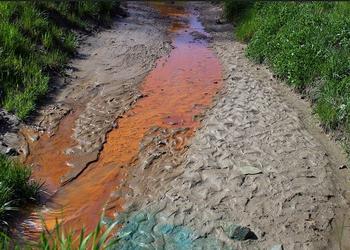
WASHINGTON, DC, February 3, 2017 (ENS) – The Senate voted Thursday to send President Donald Trump a measure to kill the Interior Department’s Stream Protection Rule, a coal mining regulation finalized in December, just weeks before the end of the Obama administration.
The resolution passed the Senate by a vote of 54-45, just one day after the House approved it by a vote of 228 to 194.
Congress, through the passage of a joint resolution known as the Congressional Review Act, and signed by the President, can overturn a regulation administered by a previous administration, within 60 legislative days of a new Congress.
“This Obama administration rule is not designed to protect streams. Instead, it was an effort to regulate the coal mining industry right out of business,” said Congressman Bill Johnson, the Ohio Republican who sponsored the disapproval measure in the House.

The rule, an update to the standards intended to protect clean water and other natural resources threatened by surface coal mining operations across the nation, was issued December 19, 2016, by the Department of the Interior’s Office of Surface Mining Reclamation and Enforcement, after almost a decade of work.
The Stream Protection Rule generated more than 150,000 comments during the lengthy public comment period that included 15 public meetings across the country.
If President Trump signs the Congressional Review Act measure, the Stream Protection Rule will be history and coal companies will be able to freely dump mining debris into streams.
Legislators also voted to roll back a separate rule requiring companies to disclose payments made to foreign governments relating to mining and drilling.
The Stream Protection Rule was intended to protect communities whose drinking water is threatened by pollution from coal mining. The rule states, “This final rule will better protect water supplies, surface water and groundwater quality, streams, fish, wildlife, and related environmental values from the adverse impacts of surface coal mining operations and provide mine operators with a regulatory framework to avoid water pollution and the long-term costs associated with water treatment.”

Mountaintop removal mining, a form of coal mining that blasts off the tops of mountains, filling the valley floors below with tons of debris, has been responsible for destroying an estimated 2,000 miles of headwater streams in Appalachia.
Opposing this type of coal mining, the nonprofit Appalacian Voices points to peer-reviewed scientific studies linking mountaintop removal mining to greater incidences of birth defects and deaths from cancer. In the semi-arid West, coal extraction threatens scarce water resources used by farmers and ranchers; in Alaska, salmon streams are often located near coal deposits.
Ranking Member of the Senate Energy and Natural Resources Committee Maria Cantwell, a Washington Democrat, attempted to defend the Stream Protection Rule from repeal.
The rule established a monitoring requirement for water pollution and prevented dewatering of streams. Addressed under the rule are toxic pollutants, including lead, arsenic and selenium, which is known to cause birth defects.
Noting that the law on this issue had not been updated in 33 years, Cantwell said, “We now have better technology, we have more information about selenium and we know that it impacts fish. We want mining companies to make sure they are doing something to minimize the impacts of selenium.”
“This administration is starting a war on clean water,” Senator Cantwell said. “Why would you want to exempt anybody from cleaning up their mess? Polluters should pay.”
Cantwell argued that reversing this regulation is not good for jobs or for the economy, saying, “I hope people aren’t advocating for pollution as an economic solution, because it won’t work.”
But Alaska Republican Lisa Murkowski, who chairs the Senate Committee on Energy and Natural Resources, argued, “In drafting this regulation, the Obama administration ignored the input and recommendations of states and stakeholders, and subverted the law to meet its policy objective – keeping coal in the ground.”
“Left intact, this rule would have cost us jobs and revenues, from Alaska to Appalachia,” Murkowski said. “By overturning it, we will avoid those significant impacts, and help ensure a continued supply of reliable, affordable energy for Americans all across the country.”

But the U.S. Energy Information Agency, EIA, says the coal industry is declining, not because of rules governing coal mining, but because of cheaper natural gas.
For decades, coal has been the dominant energy source for generating electricity in the United States, the agency said in March 2016. EIA’s Short-Term Energy Outlook is now forecasting that 2016 will be the first year that natural gas-fired generation exceeds coal generation in the United States on an annual basis.
Natural gas generation first surpassed coal generation on a monthly basis in April 2015, and the generation shares for coal and natural gas were nearly identical in 2015, each providing about one-third of all electricity generation.
The mix of fuels used for electricity generation has evolved over time. The recent decline in the generation share of coal, and the concurrent rise in the share of natural gas, was mainly a market-driven response to lower natural gas prices that have made natural gas generation more economically attractive.
Between 2000 and 2008, coal was less expensive than natural gas, and coal supplied the fuel for about half of total U.S. power generation. But beginning in 2009, the EIA explained, the gap between coal and natural gas prices narrowed, as large amounts of natural gas produced from shale formations changed the balance between supply and demand in U.S. natural gas markets.
Copyright Environment News Service (ENS) 2017. All rights reserved.
© 2017, Environment News Service. All rights reserved. Content may be quoted only with proper attribution and a direct link to the original article. Full reproduction is prohibited.
